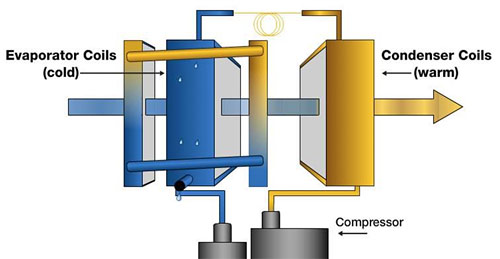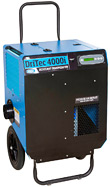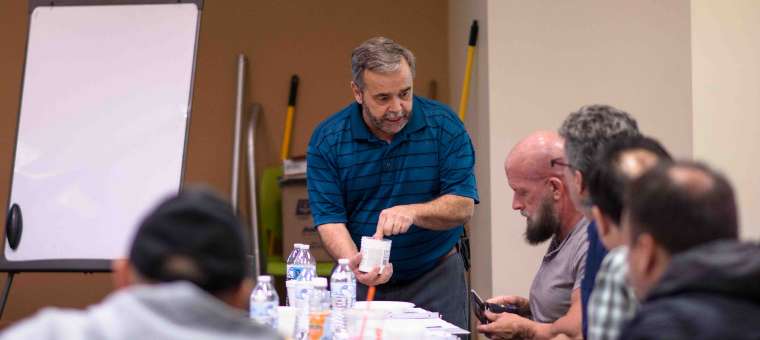Dehumidifier Selection Guide for Water Damage Restoration
Dehumidifiers are essential in reducing the moisture content of the air on water damage restoration jobs. The rate of dehumidification must exceed the rate of evaporation to create a balanced drying system and safely restore a structure to its previous state.
Three Types of Commercial Dehumidifiers
Conventional Refrigerant Dehumidifiers
What is a Conventional Refrigerant Dehumidifier?
 Conventional refrigerant dehumidifiers are the most basic portable dehumidifiers used in the restoration industry. Refrigerants remove water from the air by condensing it on cold coils (much like a cold soda pop can on a humid Summer day). Because of this, they operate most efficiently in very humid conditions, and between 70º and 90º F (21º - 32ºC).
Conventional refrigerant dehumidifiers are the most basic portable dehumidifiers used in the restoration industry. Refrigerants remove water from the air by condensing it on cold coils (much like a cold soda pop can on a humid Summer day). Because of this, they operate most efficiently in very humid conditions, and between 70º and 90º F (21º - 32ºC).
In ideal conditions, refrigerants are effective in lowering high humidity to a safe level of 40% relative humidity (RH), or about 55 grains per pound (GPP).
Conventional Refrigerants have limitations, such as low air processing, low water removal rates, and are not able to adequately reduce humidity levels in situations with large amounts of bound water.
When to Use Conventional Refrigerants for Water Mitigation
- Simple/small water losses
- As a backup dehumidifier
Low Grain Refrigerant Dehumidifiers
What is a Low Grain Refrigerant (LGR) Dehumidifier?
 LGR Dehumidifiers are the most common type of dehumidifier used by water restoration professionals. LGR refers to Low Grain Refrigerant units. Unlike Conventional Refrigerants, an LGR unit will continue to remove water below 55 grains per pound - even below 40 grains per pound (GPP).
LGR Dehumidifiers are the most common type of dehumidifier used by water restoration professionals. LGR refers to Low Grain Refrigerant units. Unlike Conventional Refrigerants, an LGR unit will continue to remove water below 55 grains per pound - even below 40 grains per pound (GPP).
LGRs were designed for flood conditions by the leading manufacturer specializing in water damage mitigation equipment.
Low Grain Refrigerants are the most energy efficient and popular dehumidifiers in the market because their performance is boosted by a built-in air pre-cooling device which supplies the dehumidifier with cooler air to process.
Three Types of LGR Pre-cooling Systems
- Heat Pipe
A looped system surrounds the cold coil, allowing refrigerant to collect heat, condense, and repeatedly re-circulate it. - Air-to-air heat exchangers
Corrugated plastic or aluminum plate-type air-to-air units are capable of pre-cooling incoming air by placing warm incoming air directly beside to the cool air exiting the cold coil. A new generation of high temperature LGRs removes water in ambient conditions up to 120°F! - Thermal siphon
Similar to the heat pipe, this unit features a stacked coil design. These are typically used on small-sized dehumidifiers and seldom found on most LGRs.
*Heat pipe and heat exchange systems are the two most often used in the water damage restoration industry.

When to Use LGRs for Water Damage Restoration
- Most residential and small commercial situations
- Warm/high humidity conditions
- To achieve drier conditions down to 34 GPP
Desiccant Dehumidifiers
What is a Desiccant Dehumidifier?
 Desiccants offer sophisticated technology that uses chemical attraction instead of condensation to extract water. So optimal dew point temperatures do not limit their performance.
Desiccants offer sophisticated technology that uses chemical attraction instead of condensation to extract water. So optimal dew point temperatures do not limit their performance.
Used correctly, they produce the driest air (lowest GPP) of any dehumidifier and are capable of most closely approximating desert-like drying conditions.
Choose a desiccant dehumidifier for dense materials like hardwood floors, for cooler or dry sites, or if location temperatures are cooler than 60°F (sub-zero desiccants work in temperatures as low as 0°F).
The restoration industry utilizes portable desiccant technology. These Portable Desiccants represent state-of-the-art dehumidifying technology, and their sizes run the gamut from small, suitcase-sized portables, to large trailer-mounted mobile units.
When to use Portable Desiccants for Water Remediation
- Very difficult to dry situations (class 4 water losses)
- In structures that cannot be warmed adequately for LGRs to be effective
For more information on how to choose the right dehumidifier or other restoration equipment, please contact a member of the Jon-Don Restoration Team at 1-800-556-6366.



